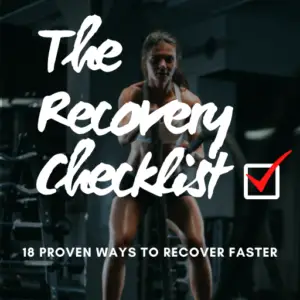A runner walks into a physical therapy clinic. “My foot hurts if I run more than 2 miles,” she says. “The doctor told me to stop running until I saw you. When can I run again?”
Patients ask me this type of question all the time. Put another way:
“Is it harmful to exercise through pain?”

Well, it depends on the condition. But it’s usually safe to work through pain. Here’s how pain influences rehab with 3 common conditions.
Shoulder Impingement
Tendon and bursa compression cause shoulder impingement pain. This condition is highly irritable and flares up easily. Inflammation drives most of the discomfort.
NSAIDs often help. So does rest. And doing the right shoulder impingement exercises.
With shoulder impingement, training through pain isn’t smart. It’s unlikely to cause damage, but it will prolong recovery.
Complete rest isn’t the only option. Reducing load and using better technique can help athletes lift weights and bench press without shoulder pain.
Sciatica
Most sciatica originates from the lumbar spine. Pain emanates from the lower back into the hip, thigh, lower leg and foot.
Pain location is crucial.
Pain radiating down the leg indicates nerve irritation. But pain creeping up the leg, towards the spine, is proven to predict better outcomes (Werneke 2001). This phenomenon is called centralization.

Physical therapists use these proven pinched nerve exercises to achieve centralization and accelerate sciatica recovery.
For sciatica, pain location tells the story. I encourage my patients with sciatica to stay active and keep an eye on their symptoms.
Pain travelling towards to the toes means “stop” or “modify.” Unchanging symptoms or pain moving towards the spine indicates the position or activity is okay.
Staying in bed is one of the worst treatments for low back pain. Back pain and sciatica guidelines encourage movement and early physical therapy to recover fast. Even if it means exercising through pain.
Plantar Fasciitis
Plantar fasciitis is a classic overuse injury. Broadly speaking, treatment involves unloading, then slowly reloading the irritated tissue.

Learn the best treatment options here: The Ultimate Guide to Plantar Fasciitis
As with most muscle and tendon issues, working through pain is fine for plantar fasciitis. Exercising into mild to moderate pain can remodel the affected tissue and speed up recovery.
However, it’s wise to avoid excruciating exercises. Activities like walking barefoot on hard floors and running on concrete can flare plantar fasciitis pain.
The 5 Principles
These principles guide exercising through pain:
1. Pro-Movement Bias
If the area is structurally intact, I instruct patients to opt for more movement instead of less. Exercise confers amazing benefits like pain reduction, stress relief, and better sleep.
I encourage my patients to exercise regularly. Even it if means modified or low-impact exercises.
2. No Changes in Technique
The body compensates to avoid pain. If pain causes someone to walk with a bad limp, they shouldn’t walk for exercise. Doing so will reinforce bad movement patterns and increase the odds of a compensatory injury.
3. Pain < 5/10
Training through severe pain isn’t healthy. Pain above 5/10 usually aggravates the problem and delays recovery. However, it’s usually fine (and even beneficial) to push through mild pain.
One study found that training through pain led to faster strength recovery after hamstring injury when compared to pain-free rehab (Hickey 2020).
4. No Lingering Effects
Pain should return to baseline levels within 24 hours. If pain levels stay elevated more than a day after exercise, it’s a sign to back off and do less next time.
5. Build Slowly
Rome wasn’t built in a day, and neither was your physical prowess. It takes time to regain strength, speed and endurance after injury. Progressing too fast will inevitably cause setbacks and frustration.

The Runner, Revisited
How do we apply these principles to the runner described earlier?
First, a few more details:
Her X-Rays show no foot fractures. The physician diagnosed tibialis posterior tendonitis, with the outside possibility of a stress fracture (those don’t always show up on X-Rays).
So she’s safe to run pain-free.
Here’s how I’d apply the 5 principles to a case like this:
1. Pro-Movement Bias
Get her back to running. Her symptoms and diagnosis indicate running is safe at this time.
2. No Changes in Technique
Check running form. If it’s symmetrical, she’s good to go.
3. Pain < 5/10
In this case, since a stress fracture is possible, I’d instruct the patient to avoid foot pain while running. Running through pain could exacerbate a stress fracture.
4. No Lingering Effects
Instruct the patient to back off (run less, or slower) if pain worsens the day after running.
5. Build Slowly
Collaborate with the patient to develop a running plan. Since she can run 2 miles before pain begins, it’s reasonable to start with 1-mile runs. Ask her to take a day off between runs to monitor symptoms and recover.
She can slowly add mileage as her symptoms permit. She will also benefit from resistance training to keep her running muscles strong. Plus, it’s the best way to prevent injuries.
Readers: How do you handle pain with exercise? Do you prefer to push through it or shut it down? Let me know in the comments.
For more evidence-based insights you won’t find anywhere else, join the free, fast-growing Facts & Physio Newsletter. Plus, get The Recovery Checklist when you sign up.

